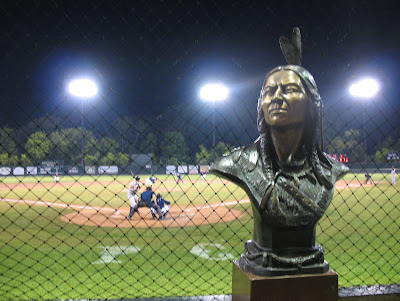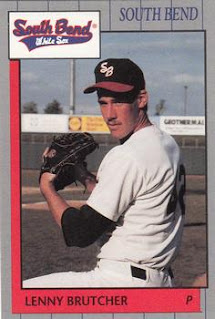Interview Part 2: Randy Hennis, Worked For
 |
| The Ohio River from Cincinnati's Great American Ballpark in 2010. Randy Hennis got his first major league start in Cincinnati, at old Riverfront Stadium. (G21D Photo) |
Part 1: Biggest Jolt | Part 2: Worked For | Part 3: Stat Line
There was talk that Randy Hennis would get his call to the bigs earlier in the year, he recalled recently. But that never materialized.
When the call came that September in 1990, Hennis was ready.
"It's what you're working for, what you spent your time and effort in achieving," Hennis recalled recently to The Greatest 21 Days. "When you finally get there, it's a rush of adrenaline. It's a rush of elation. It's emotional. It's kind of like, hey, I finally get the opportunity to do this thing that very few people ever get a chance to do."
"I was as excited and as happy," Hennis added, "as I probably have ever been in my life."
Hennis packed his things and he was off to Houston. He went on to get three outings with the Astros to finish out the year. He didn't give up a run. He also never appeared in the majors again.
Hennis spoke to The Greatest 21 Days by phone recently from his adopted home state of Florida.
Hennis told of the tough decision to turn down the Bombers for college baseball at UCLA, then finally turning pro after his junior year after being taken in the second round by the Astros.
As a pro, Hennis worked his way through the minors, before breaking through as a September call up in 1990. Hennis told of having that early success, then dealing with the injuries that came later and finally ended his playing days with that singularly distinctive major league stat line marking brief career in the bigs.
 |
| The Great American Ballpark field. Randy Hennis pitched six innings of shutout ball at old Riverfront Stadium in 1990. (G21D Photo) |
Hennis' call to Houston in 1990 actually came after he'd begun to think it might not come at all, he recalled. The AAA season was over and he'd returned home.
Taking the phone call from the Astros was Hennis' father, Neal. Once Hennis got word at a friend's house, Hennis recalled running home, packing his stuff and hoping on a plane to Houston.
He arrived and just took everything in.
"Just like everything, when you're going somewhere new and exciting, somewhere you've always wanted to be, you're just in a constant state of euphoria," Hennis said. "When you walk into the stadium for the first time, walk into the locker room and out onto the field, it's just kind of hard to explain.
"It's just one of those feelings you really can't duplicate many times in life."
 |
| The board references Herm Winningham. Winningham went 0 for 2 with a walk against Randy Hennis in 1990. (G21D Photo) |
He pitched well from the start.
His first action came Sept. 17 at home in the Astrodome. It also came against his hometown team, the Padres, and it came in relief.
The situation for his major league debut: Two men on and one out. The Astros were already behind 5-0, but he was relieving Danny Darwin, the league ERA leader. Hennis needed to keep those runners from scoring.
Hennis induced a pop out from Benito Santiago. He then struck out Mike Pagliarulo, getting out of the jam. He then pitched a perfect sixth inning, marking the extent of his night.
Hennis recalled that the time before games are when the nervousness comes. That changes once you're in the game.
 |
| Luis Quinones coaching with Oneonta in 2009. Quinones faced Randy Hennis Oct. 3, 1990 with Cincinnati. He went 0 for 2. (G21D Photo) |
Hennis' second outing came Sept. 23, in Atlanta. This time, he went two innings, giving up no hits, no runs and he struck out two.
His third and final outing came Oct. 3, against the eventual world champion Reds. It was a start.
It was the final game of the year, Hennis recalled. The game was also on ESPN, so he knew everyone back home in San Diego would be able to see him pitch.
Also able to see him pitch, but from the stands in Cincinnati, was Hennis' father, Neal. "That was real important to me and very special that he was able to be there to see that," Hennis said.
 |
| Home plate at Great American Ballpark in Cincinnati. Randy Hennis faced the Reds in his only major league start. (G21D Photo) |
Then, with one out in the sixth, Hennis gave up a broken bat double to Ron Oester. It was the first hit Hennis gave up in the majors.
Hennis finished out the inning and Hennis was done.
"Obviously, your dream would be to go all the way and pitch a no hitter, but so many things can happen to take it away," Hennis said. "But, for my first start, I would take that for my first start anytime. I think pretty much anybody would."
Before that Oester double, Hennis did have a career no-hitter. In his first three outings, he went nine full innings before giving up that first hit. He ended the season with 9.2 innings of work and that one hit. He didn't give up a run.
With that kind of showing, the hope was Hennis would return to the bigs at some point in 1991. He ended up starting at AAA. Then injuries came.
Part 1: Biggest Jolt | Part 2: Worked For | Part 3: Stat Line
Read Part 3: Randy Hennis, Stat Line







